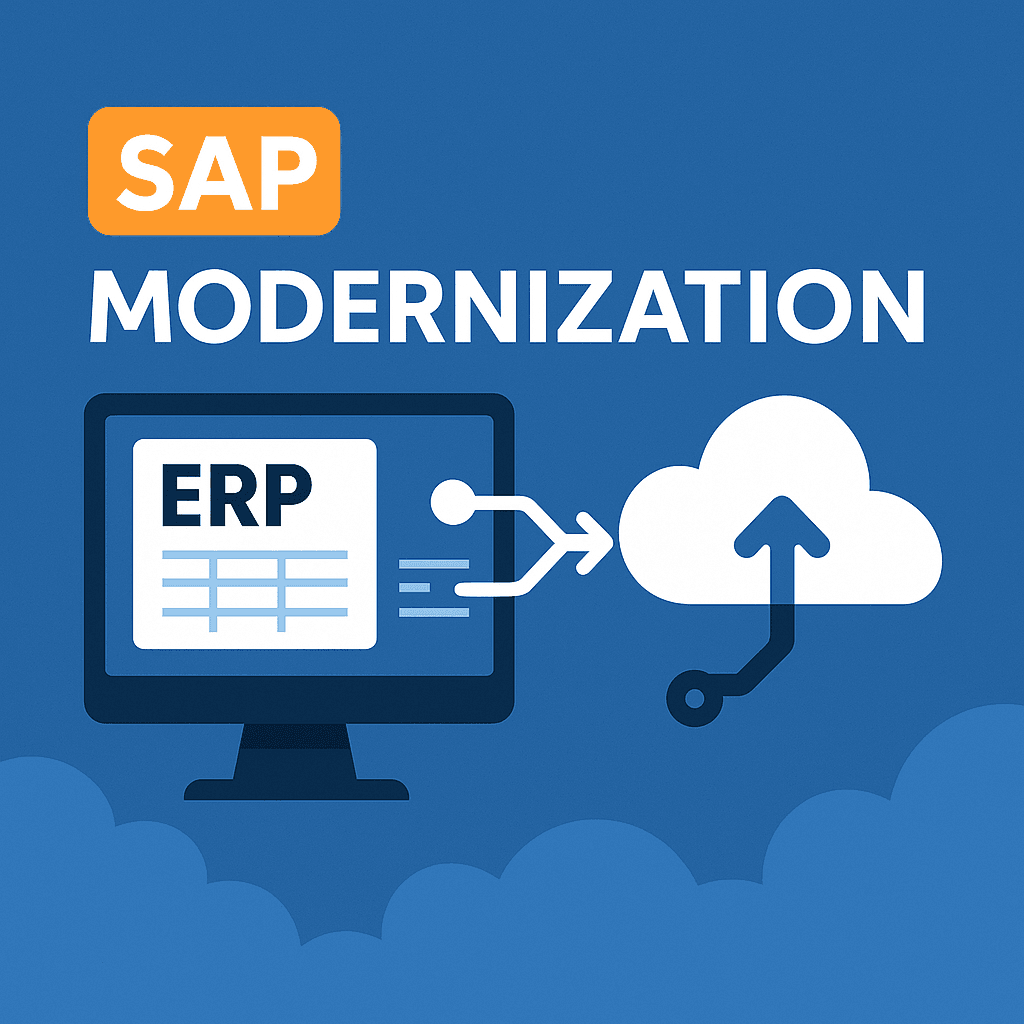Learn how to modernize SAP ECC to S/4HANA before 2027. This SAP modernization guide explains key migration steps, costs, and how API-based EDI from Orderful simplifies integration and compliance.
What Is SAP Modernization?
SAP modernization is the process of upgrading older SAP systems — such as ECC — to the next-generation SAP S/4HANA platform. It often involves cloud migration, process redesign, and adopting modern integration methods. In simple terms, modernization means transforming an aging, on-premises ERP into a future-ready, digital-first foundation.
The timing couldn’t be more critical. SAP has announced end-of-support dates for ECC and older systems, with mainstream maintenance ending in the next few years. The shift also represents a competitive advantage for early adopters. Companies that modernize their SAP ERP system early gain faster analytics and more agile business processes.
Modernization gives you the chance to re-evaluate enterprise architecture and embrace technologies that drive measurable business value. Modernization is an opportunity to streamline integrations and simplify electronic data interchange (EDI) processes. By connecting with an API-driven EDI platform like Orderful, you can accelerate partner onboarding and ensure smooth data exchange across every trading partner.
Why SAP Modernization Is Critical Now
The objective behind SAP modernization is to prepare businesses for the next decade of growth, resilience, and digital transformation. With SAP announcing the end of mainstream maintenance in 2027 and extended support running only through 2030, most companies now face a clear choice. Modernize soon or risk falling behind.
According to industry research, thousands of organizations are already on the migration journey. A 2023 report found that around 22,000 customers had licensed S/4HANA, with roughly two-thirds having deployed. The pace is accelerating as enterprises realize that delaying modernization increases cost and project complexity.
Legacy SAP vs. Modernized SAP
Capability | Legacy SAP | Modernized SAP (S/4HANA) |
|---|---|---|
Support | Ends 2027/2030 | Full support |
Deployment | On-premises | Cloud / Hybrid |
Integration | Batch-based, manual EDI | API-first, cloud-native EDI |
Analytics | Limited, batch reporting | Real-time, predictive |
UX | SAP GUI | SAP Fiori + mobile-ready |
It's clear that moving from legacy SAP ERP environments to S/4HANA is an essential business transformation that can put your organization in a position to operate with improved up-to-the-minute insights and the ability to innovate faster than competitors still tied to legacy systems.
Key Steps for Successful SAP Modernization
Every SAP modernization project looks a little different, but the most successful ones follow a structured approach. Whether your company is beginning its SAP S/4HANA migration or refining its SAP modernization strategy, these steps can help reduce complexity, control costs, and deliver measurable value.
1. Assess Your SAP Landscape
Start by taking inventory of your existing ERP system, including modules, custom code, integrations, and infrastructure. This assessment helps identify dependencies and areas where modernization may introduce risk. Many companies also uncover opportunities to simplify overly customized workflows or retire obsolete extensions that no longer serve business goals.
Checklist:
Catalog SAP modules, interfaces, and third-party integrations.
Document compliance gaps and data dependencies.
Evaluate infrastructure performance and scalability.
This early visibility creates the foundation for an accurate implementation roadmap and a smoother project later on.
2. Define Your Modernization Strategy
Not all SAP migrations follow the same path. Organizations typically choose between these methods:
Brownfield (system conversion): Upgrading your existing SAP ECC system to S/4HANA with minimal disruption.
Greenfield (new implementation): Starting fresh with a clean S/4HANA installation and redesigned processes.
Selective data transition: Combining both approaches—retaining critical data and configurations while modernizing selectively.
Each model offers distinct benefits and tradeoffs. The right strategy depends on your current system’s complexity, data quality, and long-term business requirements. Take a look at our ERP migration guide for more insight into choosing the right path.
3. Plan Data Migration and Data Quality
Data is the backbone of every modernization project. Before migrating, clean and validate your data to eliminate duplicate entries, outdated records, and inconsistent formats. Incomplete or inaccurate data can lead to costly delays and rework once the new system is live.
Common pitfalls and solutions:
Duplicate entries: Implement automated validation rules.
Legacy formats: Map data fields to S/4HANA structures early.
Incomplete data: Identify gaps through sandbox testing.
A clean, standardized data set helps ensure a smooth SAP migration and more reliable reporting from the start. If you’re preparing for a large-scale transition, our guide on preparing for ERP migration can help you get started.
4. Select Your Deployment Model (Cloud vs. Hybrid)
You can deploy S/4HANA in several different ways. Each offers a different balance of control, flexibility, and cost.
Method | Description | Pros | Cons |
|---|---|---|---|
Public Cloud | Fully managed SAP infrastructure | Lower costs, faster upgrades | Limited customization |
Private Cloud | Dedicated environment hosted on SAP or partner servers | High control and security | Higher total cost |
Hybrid | Mix of on-premises and cloud workloads | Flexibility for gradual transition | More complex to manage |
RISE with SAP offers an all-in-one subscription that includes S/4HANA, cloud infrastructure, and managed support, making it easier for companies to modernize without large upfront investments. Review our guide on SAP HANA migration for deeper planning insights.
5. Address Customizations and Extensions
Over time, many SAP environments accumulate custom code and integrations that complicate upgrades. As part of your modernization planning, evaluate which ones add real business value and which ones you can simplify or retire.
Best practices:
Minimize changes to the S/4HANA core whenever possible.
Use SAP Business Technology Platform (BTP) for custom extensions.
Document each change thoroughly to avoid maintenance challenges.
Keeping your environment lean supports smoother updates and reduces long-term technical debt.
SAP S/4HANA Migration Pathways
Modernizing your SAP environment means choosing how to get from where you are today to a fully optimized SAP S/4HANA landscape. Every organization’s journey is unique, but most follow one of three primary SAP migration pathways. Each has its own timeline, cost profile, and innovation potential.
1. System Conversion (Brownfield Approach)
This option upgrades your existing SAP system directly to S/4HANA. It’s best suited for companies that want to preserve their current processes and data structures while still gaining the benefits of the new platform.
Speed: Fastest migration method since it reuses existing configurations.
Risk level: Moderate. Complex custom code may require rework.
Innovation potential: Limited, since legacy processes largely remain intact.
2. New Implementation (Greenfield Approach)
The greenfield path involves starting fresh with a completely new S/4HANA system. It’s ideal for companies that want to redesign outdated processes or eliminate years of technical debt.
Speed: Longer timeline, typically 12–24 months depending on scope.
Risk level: Lower, since you’re building from a clean slate.
Innovation potential: Highest, with the ability to fully embrace modern best practices and automation.
3. Selective Data Transition (Hybrid Approach)
This method combines elements of both brownfield and greenfield migrations. You selectively carry forward only the data, configurations, or modules that add measurable value to your business.
Speed: Flexible — often faster than full greenfield implementations.
Risk level: Moderate. Data selection requires careful planning.
Innovation potential: Balanced. Modernize core processes without rebuilding everything from scratch.
Pathway | Best For | Speed | Innovation Potential | Risk Level |
|---|---|---|---|---|
Brownfield | Companies upgrading existing ECC systems | Fast | Limited | Moderate |
Greenfield | Businesses reengineering processes from the ground up | Slow | High | Low |
Selective Data Transition | Organizations blending old and new elements | Moderate | Medium–High | Moderate |
For many enterprises, RISE with SAP simplifies the decision. It offers a managed, subscription-based path that supports each of these migration options and integrates cloud infrastructure, security, and ongoing updates. Whether your goal is speed, stability, or innovation, the right migration strategy provides a clear path forward that reduces risk while maximizing business value.
Data Integration and EDI Modernization
A successful SAP modernization ensures that your data and partner connections are ready for modern business demands. As organizations move forward, many discover that legacy EDI systems and VAN connections are among the biggest sources of friction during migration.
Older setups often rely on batch-based processing and time-consuming partner onboarding. These systems make scaling difficult and increase compliance risks, and carrying forward those limitations can undermine the benefits of your new environment.
Upgrading to an API-driven integration platform eliminates the complexity of traditional EDI by connecting trading partners through a single, cloud-based network. Instead of maintaining dozens of point-to-point connections, your team can exchange transactions in real time using standardized templates and built-in validation tools.
Modern EDI accelerates time to value by reducing onboarding from months to days, improving data accuracy, and freeing your team to focus on higher-value work.
Orderful Can Help
Orderful’s API-first EDI platform complements SAP modernization by automating validation, testing, and partner onboarding. With real-time visibility into transactions, you can reduce migration risks and keep supply chain operations running smoothly throughout your transformation.
For a deeper look at how cloud-based integration supports long-term success, explore our resources on understanding modern EDI and reducing EDI integration costs with Orderful.
The Path Forward for SAP Modernization
Modernizing your SAP cloud ERP environment is a strategic opportunity to future-proof your operations. By moving to SAP's new ERP system and adopting modern integration tools, your business gains the flexibility, speed, and insight needed to stay competitive long after ECC support ends.
Orderful helps organizations simplify that journey. With a single API connection, you can connect to every trading partner, eliminate manual mapping, and accelerate onboarding during your migration. If you're ready to see how modern EDI can keep your business moving, contact an EDI expert today or book a demo to get started.
FAQs About SAP Modernization
What is SAP modernization?
SAP modernization is the process of upgrading legacy SAP ERP systems, such as ECC, to the modern S/4HANA platform. It often includes cloud migration, process redesign, and modern EDI or API-based integrations that improve agility and compliance.
Why is SAP modernization important in 2026?
SAP modernization is crucial in 2026 because SAP’s mainstream maintenance for ECC ends in 2027. Companies that upgrade early to S/4HANA reduce risk, cut costs, and gain faster analytics, scalability, and innovation opportunities.
How long does SAP modernization take?
The SAP modernization timeline varies by project scope. A brownfield conversion may take 6–12 months, while a greenfield implementation can span 12–24 months. Using prebuilt integrations and automated testing can significantly shorten migration time.
How much does SAP modernization cost?
SAP modernization costs depend on factors like system complexity, data volume, and chosen migration strategy. Costs can range from several hundred thousand to several million dollars, but cloud models and RISE with SAP subscriptions reduce upfront investments.
Can SAP modernization be phased?
Yes, modernization can be phased through a selective data transition approach. This lets you migrate critical data and modules first, minimizing disruption and enabling a smoother transformation to S/4HANA.
How does SAP modernization impact EDI connections?
Modernizing SAP improves EDI connections by replacing legacy, batch-based systems with real-time API integrations. Platforms like Orderful streamline partner onboarding, automate validation, and ensure seamless data exchange during and after migration.
What skills are needed for SAP modernization?
Successful SAP modernization requires expertise in ERP architecture, data migration, cloud infrastructure, and API/EDI integration. Teams also need project management and compliance skills to ensure a secure and efficient transition.

